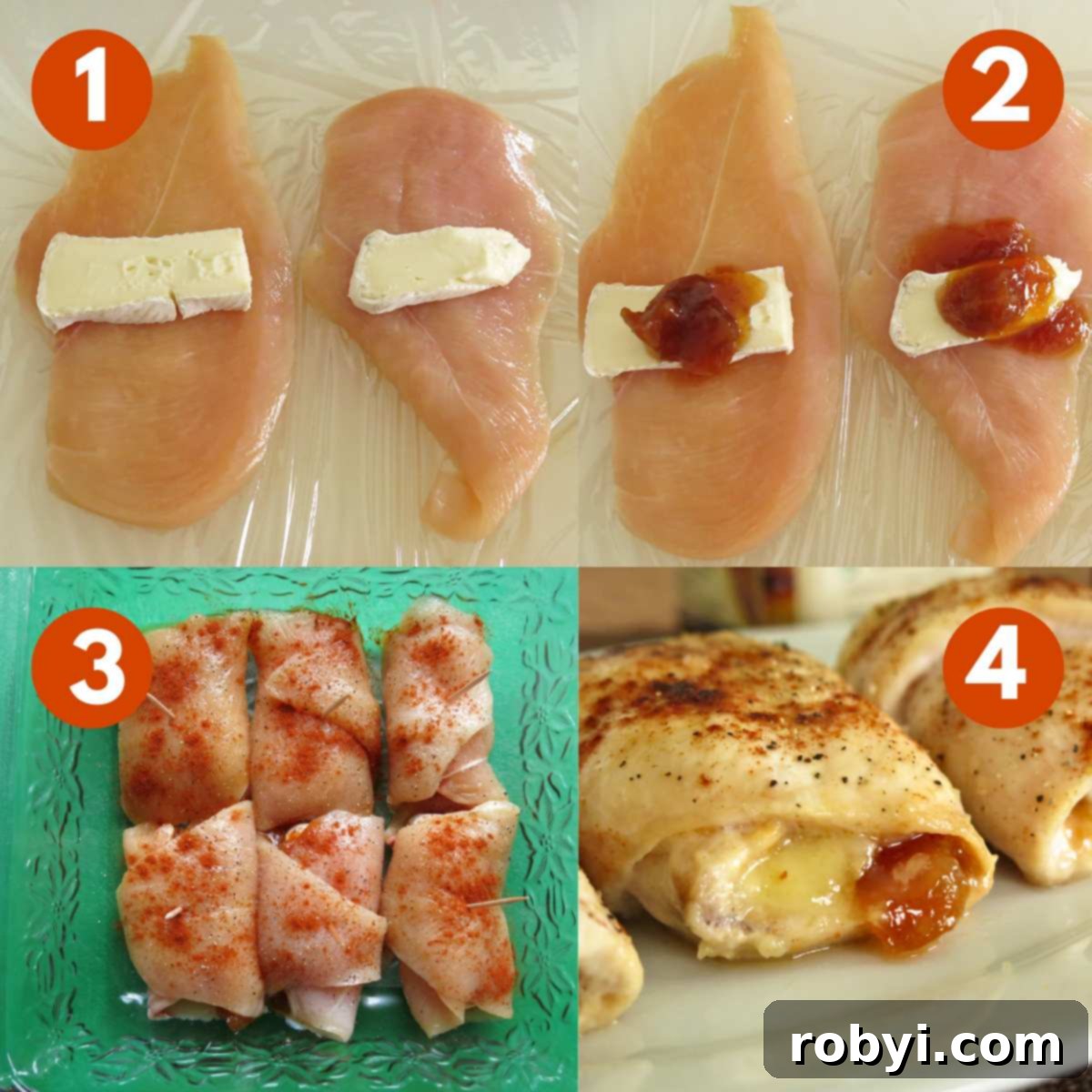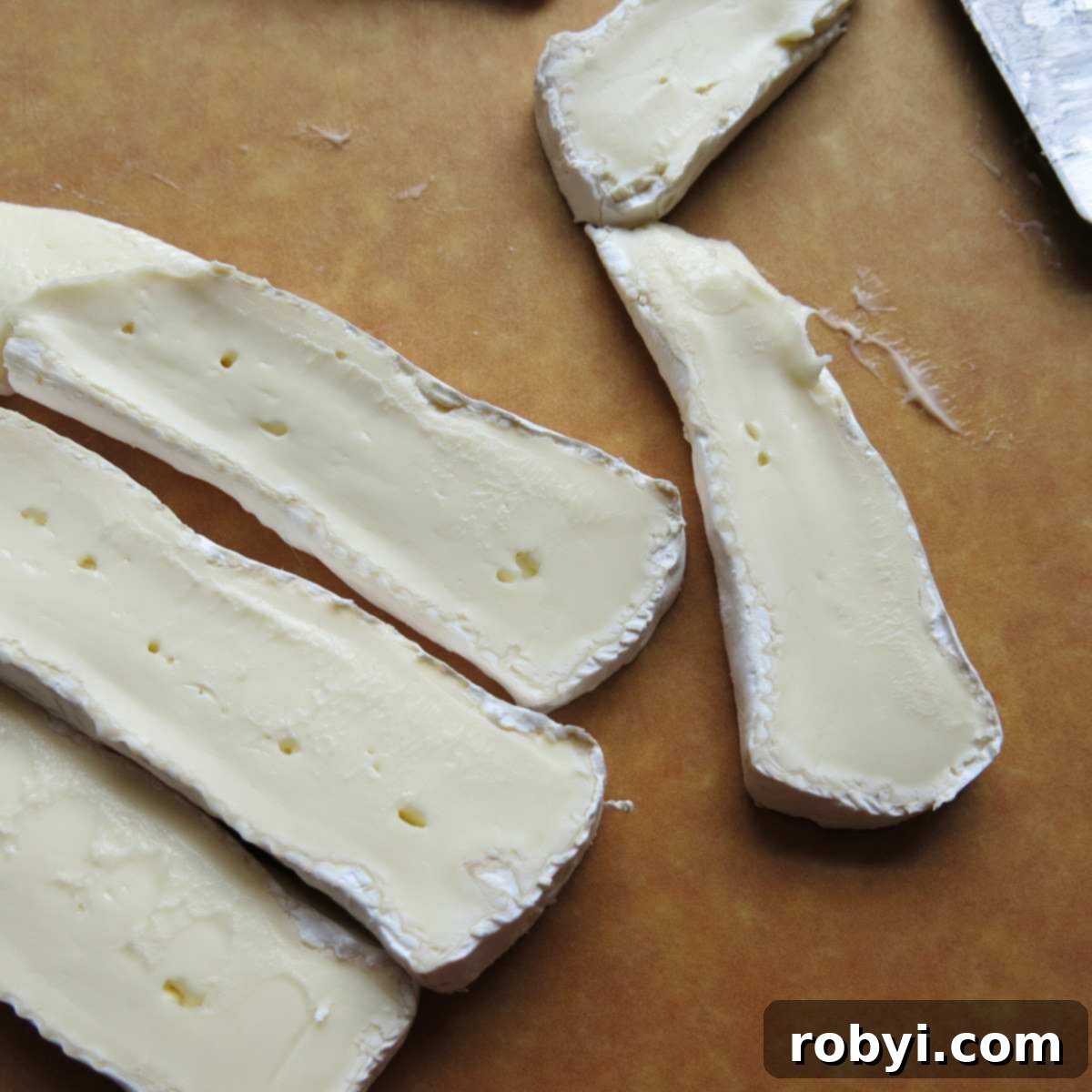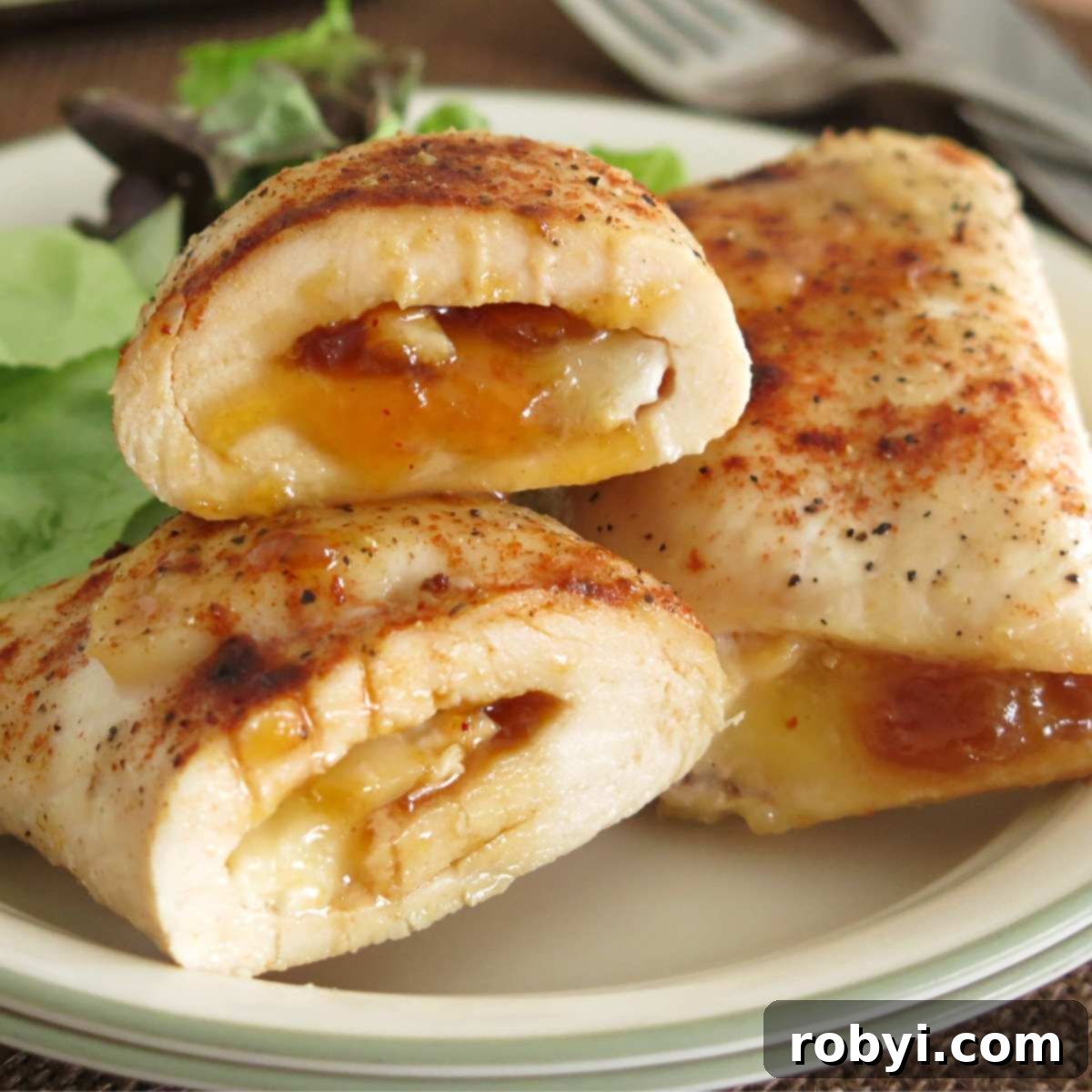Chicken Roulades, elegantly stuffed with creamy brie and a vibrant mango chutney, offer an exquisite culinary experience that’s surprisingly simple to prepare. This sophisticated yet approachable dish proves that extraordinary flavors can be crafted with just a handful of quality ingredients, making it perfect for both impressive dinner parties and delightful weeknight meals. The harmonious blend of savory chicken, rich cheese, and sweet-tangy chutney creates a symphony of taste that will captivate your palate.

There’s an undeniable magic in dishes that achieve profound flavor through the thoughtful pairing of simple components. This recipe for oven-baked chicken roulades is a prime example, showcasing how a few core ingredients can transform into something truly spectacular. Imagine tender, juicy chicken breast encasing a luxurious filling that melts and oozes, contributing to a rich, aromatic sauce that you’ll want to savor spoonful by spoonful. This is not just a meal; it’s an experience.
Why You’ll Love These Mango Chutney & Brie Chicken Roulades
This particular chicken roulade recipe stands out for several compelling reasons, making it a beloved choice for home cooks and culinary enthusiasts alike. Firstly, the flavor combination of creamy brie and tangy mango chutney is nothing short of heavenly. Brie, with its rich, buttery notes, beautifully complements the sweet and slightly spiced complexity of mango chutney. When rolled inside lean chicken breast, these ingredients meld during baking, creating a succulent and incredibly flavorful interior that is both comforting and exotic.
Secondly, despite its elegant appearance, this dish is remarkably easy to prepare. The prep time is minimal, and the baking process is straightforward, requiring little hands-on attention. This makes it an ideal candidate for busy weeknights when you desire a gourmet meal without the lengthy fuss. Yet, its sophisticated taste and presentation also make it perfectly suited for special occasions, date nights, or entertaining guests. It strikes that coveted balance between simplicity and sophistication.
Finally, the natural juices and melted cheese that escape the roulades during baking create a delightful, ready-made sauce. This flavorful reduction ensures that every bite is moist and packed with the signature tastes of mango and brie, eliminating the need for additional sauce preparation. It’s a complete culinary package that consistently earns rave reviews from those who try it.
What Are Chicken Roulades?
The term “roulade” originates from French cuisine, meaning “to roll.” In the culinary world, it typically refers to a dish where a piece of meat – such as chicken, beef, or pork – is flattened, filled with various ingredients, and then rolled up before being cooked. This technique allows for a creative combination of flavors and textures within a single, elegant presentation. Chicken roulades, specifically, involve using boneless, skinless chicken breasts or cutlets, which are pounded thin to create a uniform canvas for the filling. Once filled and rolled, they are often seared, baked, or braised until the chicken is cooked through and the filling is warm and melty. Roulades are prized for their versatility, as the filling possibilities are virtually endless, allowing for both classic and innovative flavor profiles, much like our mango chutney and brie version.
Ingredients for Mango Chutney & Brie Chicken Roulades
Crafting these delectable chicken roulades requires a careful selection of a few key ingredients, each playing a crucial role in the dish’s overall success and flavor profile. Here’s a closer look at what you’ll need and some tips for choosing the best quality components:
- Boneless, Skinless Chicken Breasts: The foundation of our roulades. For best results and even cooking, you’ll want chicken breasts pounded to an approximate ¼-inch thickness. This ensures they cook quickly and remain tender. To save time, you can purchase pre-sliced chicken cutlets or thinly sliced chicken breasts from your local butcher or grocery store. Alternatively, learn how to flatten them yourself in the section below.
- Mango Chutney: This sweet and tangy condiment is the star of the filling, bringing a unique fruity and spiced dimension to the dish. You can find excellent jarred mango chutney varieties in most supermarkets, often in the international aisle or near other condiments. Look for a brand with a good balance of sweetness, acidity, and subtle spice. For an extra touch of homemade goodness, consider making your own; Simply Recipes offers a fantastic homemade mango chutney version that’s worth the effort.
- Brie Cheese: Known for its luxurious, creamy texture and mild, buttery flavor, brie cheese perfectly complements the mango chutney. It melts beautifully, creating a rich, luscious core within the chicken. While brie is highly recommended for its unique characteristics, if you’re looking for a more budget-friendly option or a slightly different flavor profile, cream cheese also works well, offering a tangy creaminess. Goat cheese is another excellent alternative, providing a sharper, more piquant note.
- Paprika: This vibrant spice is used to season the exterior of the chicken roulades, adding a beautiful reddish hue and a subtle sweet, peppery flavor that enhances the chicken without overpowering the delicate filling. Both sweet and smoked paprika work well, with smoked paprika offering a deeper, more robust aroma.
- Salt and Pepper: Essential for seasoning the chicken and bringing out the best in all the flavors. Always season generously to taste, ensuring a well-balanced dish.
Have extra mango chutney on hand? Don’t let it go to waste! It’s fantastic with juicy and delicious mango chutney turkey burgers, adding a gourmet twist to your burger night!
For the precise quantities and comprehensive instructions, please refer to the detailed recipe card provided further down.
How to Flatten Chicken Breasts for Roulades
Achieving an even thickness in your chicken breasts is key for perfectly cooked roulades. This ensures that the chicken cooks uniformly, preventing dry spots and promoting tender results. Here’s a simple method to flatten chicken like a pro:
- Prepare Your Workspace: Place a cutting board on a stable surface. Lay a piece of plastic wrap or parchment paper on the cutting board.
- Position the Chicken: Place one boneless, skinless chicken breast on the plastic wrap. Cover the chicken breast with another piece of plastic wrap or parchment paper. This prevents sticking and splattering, making cleanup much easier.
- Pound Evenly: Using the flat side of a meat mallet, gently but firmly pound the chicken. Start from the thickest part in the center and work your way outwards towards the edges. The goal is to create a uniform thickness of about ¼-inch across the entire breast. Be careful not to tear the chicken meat. If you don’t have a meat mallet, the bottom of a heavy skillet or rolling pin can work just as well.
- Check for Evenness: Lift the top layer of plastic wrap and inspect the chicken. If there are any thicker spots, continue to pound gently until the entire piece is of consistent thickness.
Alternative Methods: If pounding isn’t your preferred method or you’re short on time, you have a couple of other options:
- Buy Chicken Cutlets: Many grocery stores sell pre-cut chicken cutlets, which are already thinly sliced. This saves you the pounding step entirely.
- Butterfly and Stuff: Instead of rolling, you can butterfly a thicker chicken breast (cut it almost all the way through horizontally, then open it like a book). You can then create a pocket to stuff the ingredients inside, folding it over rather than rolling.
Step-by-Step Directions for Perfect Chicken Roulades
Making these elegant chicken roulades is a straightforward process that yields impressive results. Follow these simple steps, complete with visual guidance, to create a dish that will wow your family and friends:

- Prepare Your Oven and Chicken: Begin by preheating your oven to 350°F (175°C). While the oven heats, lay your flattened chicken cutlets (or pounded chicken breasts) flat on a piece of parchment paper or a clean cutting board. Season both sides of each chicken piece generously with salt and freshly ground black pepper.
- Prepare the Brie: If using a wedge of brie, cut it into slices approximately ⅜ inch thick, ensuring they are roughly the width of your chicken pieces. If preferred, you can remove the rind, though it’s perfectly edible and melts into the sauce.
- Assemble the Roulades:
- Place a slice of brie cheese in the center of each seasoned chicken piece.
- On top of the brie, add a heaping teaspoon of mango chutney. Be mindful not to overfill, as this can make rolling difficult.
- Carefully roll each chicken piece, starting from one end and moving to the other, making sure to keep the brie and mango chutney nestled securely in the center. If necessary, use a toothpick or kitchen twine to secure the roulade. This helps the roulades maintain their shape during baking and keeps the delicious filling contained.
- Season and Bake: Arrange the rolled chicken roulades in a baking dish or on a baking sheet with rimmed edges (to catch any delectable juices that may ooze out). Sprinkle the tops of the roulades with paprika for a beautiful color and a hint of sweet pepperiness, along with a final dash of salt and pepper.
- Cook to Perfection: Bake uncovered for approximately 25-30 minutes, or until the chicken is thoroughly cooked and golden brown. To ensure doneness, insert an instant-read thermometer into the thickest part of the roulade; it should register an internal temperature of 165°F (74°C). The exact cooking time may vary slightly depending on the thickness and size of your chicken roulades.
- Serve and Enjoy: As the chicken bakes, some of the creamy brie and tangy mango chutney will inevitably melt and ooze out, mixing with the chicken juices to create a rich, flavorful sauce at the bottom of the baking dish. Do not let this go to waste! Spoon this glorious sauce generously over the top of the chicken roulades before serving. This step is crucial for enhancing the flavor and moisture of the finished dish.
Expert Tips for Working with Brie Cheese
Brie is a soft, decadent, and creamy cheese renowned for its delicate flavor and luxurious texture. While a true delicacy, it can be a bit tricky to handle if not managed correctly. Here are some expert tips to ensure your brie behaves beautifully in your chicken roulades:
- Keep it Cold: The most important rule when working with brie, especially for slicing, is to keep it thoroughly chilled. Brie can become very gooey and difficult to slice cleanly if left at room temperature for too long. Place it in the refrigerator until just before you’re ready to cut it.
- Precise Slicing: For this recipe, aim to cut the brie into slices that are about ⅜ inch thick. This thickness allows it to melt perfectly without completely disappearing or gushing out too quickly. A sharp, thin-bladed knife, warmed slightly under hot water and dried, can help achieve cleaner cuts.
- To Remove or Not to Remove the Rind: The white, bloomy rind on brie cheese is entirely edible and is actually part of the cheese’s character. In this recipe, we did not remove it. When baked, the rind softens and integrates beautifully with the melted cheese and chutney, contributing to the overall flavor and texture. However, if you prefer a rind-free experience, you certainly can remove it.
- How to Remove the Rind (Optional): If you choose to remove the powdery outer skin, use a sharp knife to carefully slice it off, or even scrape it away with the edge of a spoon. Be gentle, as the cheese beneath is very soft.
- Consider Cream Cheese or Goat Cheese: If brie is unavailable, outside your budget, or if you simply prefer a different flavor profile, cream cheese or goat cheese can be excellent alternatives. Cream cheese will offer a milder, tangier creaminess, while goat cheese will introduce a distinct, earthy piquancy that pairs wonderfully with mango chutney.

Storage, Reheating, and Make-Ahead Instructions
These chicken roulades are fantastic for meal planning, offering flexibility for storage and reheating. Here’s how to handle them:
- Storage (Cooked): Store any leftover cooked chicken roulades in an airtight container in the refrigerator for up to 3 days. For longer storage, they can be frozen for up to 2 months. Make sure they are completely cooled before storing.
- Reheating (Cooked): To reheat, first, drizzle any accumulated juices over the top of the chicken roulades for added moisture. Cover the dish with foil and warm them in the oven on low heat (around 325°F / 160°C) until heated through, typically 15-20 minutes. Alternatively, you can reheat them gently in the microwave at 50% power to prevent the chicken from drying out, checking frequently until warm.
- Make Ahead (Uncooked): Chicken roulades are an excellent make-ahead meal. Prepare the chicken roulades up to the point where they are rolled, seasoned, and ready for baking. Place them in a single layer in a freezer-safe container or freezer bag, separated by parchment paper if stacking. Cover, label with the date, and store in the freezer for up to two months.
- Cooking from Frozen (Make Ahead): When you’re ready to enjoy this dish, transfer the frozen roulades to the refrigerator and allow them to defrost completely overnight. Once thawed, cook them as usual according to the recipe instructions. You may need to add a few extra minutes to the baking time to ensure they reach the proper internal temperature.

What to Serve with Chicken Roulades
Chicken roulades, with their rich flavors and elegant presentation, pair beautifully with a variety of side dishes. Here are some ideas to complement your meal:
- Roasted Vegetables: A medley of roasted vegetables adds vibrant color, texture, and nutrition. Asparagus, Brussels sprouts, broccoli, or sweet potatoes tossed with olive oil, salt, and pepper, then roasted until tender-crisp, are excellent choices. Their earthy flavors provide a wonderful contrast to the sweetness of the mango chutney.
- Rice Pilaf or Couscous: A classic and versatile side. Rice pilaf, with its aromatic herbs and subtle savory notes, is perfect for soaking up the delicious juices and sauce that ooze from the roulades. Couscous, being lighter and quicker to prepare, offers a similar absorbent quality with a different texture.
- Simple Green Salad: To balance the richness of the chicken and cheese, a crisp green salad with a light vinaigrette is ideal. Consider adding some fresh fruit (like mandarin oranges or sliced apples) or toasted nuts (such as pecans or walnuts) to the salad for an extra pop of flavor and crunch.
- Creamy Mashed Potatoes or Cauliflower Mash: For ultimate comfort, classic mashed potatoes are always a crowd-pleaser. The creamy texture provides a soothing counterpoint to the chicken. If you’re aiming for a lighter, carb-conscious option, mashed cauliflower is a fantastic substitute, offering a similar creaminess with fewer calories.
- Warm, Crusty Bread: Don’t let a single drop of the incredible sauce go to waste! Serve with warm, crusty bread or dinner rolls to sop up any leftover juices and melted cheese. A good sourdough or a rustic baguette would be perfect.
- Wine Pairing: For a delightful wine pairing, consider a crisp Sauvignon Blanc to cut through the richness and complement the tangy mango, or a light-bodied Chardonnay (unoaked or lightly oaked) that can stand up to the creamy brie without overpowering the chicken.
Frequently Asked Questions About Chicken Roulades
Here are answers to some common questions you might have about making chicken roulades:
“Roulade” is a French culinary term literally meaning “to roll.” In cooking, it refers to a dish made from a slice of meat (such as chicken, beef, or pork) that is flattened, filled with various ingredients like vegetables, cheese, or other meats, and then rolled up before being cooked. The filling is encased by the meat, creating a cohesive and flavorful presentation.
Absolutely! While brie offers a unique creamy and buttery flavor, you can certainly experiment with other cheeses. Cream cheese is a good budget-friendly and tangy option. Goat cheese provides a more piquant and earthy flavor. Provolone or mozzarella could also work for a classic Italian-inspired roulade, but ensure they melt well and complement your chosen filling.
A little oozing is expected and desirable as it creates a delicious sauce! However, to minimize excessive leakage, ensure your chicken breasts are pounded to an even thickness and that you don’t overfill them. Rolling the chicken tightly and securing it with toothpicks or kitchen twine can also help keep the filling contained during baking. Using slightly chilled brie will also help it hold its shape initially.
Place chicken breasts between two sheets of plastic wrap or parchment paper. Use the flat side of a meat mallet (or a heavy rolling pin/skillet) to gently and evenly pound the chicken, starting from the center and working outwards, until it’s about ¼-inch thick. This method ensures even cooking and helps the chicken remain tender.
Yes, you can! To pan-sear, brown the roulades on all sides in an oven-safe skillet over medium-high heat for about 2-3 minutes per side until golden. Then, transfer the skillet to a preheated oven (around 375°F / 190°C) and bake for 10-15 minutes, or until the internal temperature reaches 165°F (74°C). This method gives a crispier exterior.
More Delicious Chicken Recipes
- Chicken Marbella (with Boneless Breasts)
- Copycat Alice Springs Chicken Recipe
- Parmesan Herb Crusted Chicken Recipe
Would you like more easy, healthy, carb-conscious recipes?
📋 Recipe: Chicken Roulades Stuffed with Mango Chutney and Brie

Chicken Roulades Stuffed with Mango Chutney and Brie
These elegant and easy stuffed chicken roulades, filled with vibrant mango chutney and creamy brie, take just minutes to prepare and are perfect for any occasion!
Prep Time: 10 minutes
Cook Time: 25 minutes
Total Time: 35 minutes
Servings: 4 servings
Author: Marjory Pilley
Print Recipe
Ingredients
- 20 ounces boneless, skinless chicken breast cutlets (about ¼ inch in thickness)
- 4 ounces brie cheese (from a small wedge)
- 4 teaspoons mango chutney (plus extra to serve over the top if desired)
- 1 teaspoon paprika
- Salt and pepper to taste
Instructions
- Preheat oven to 350°F (175°C).
- Lay chicken cutlets flat on a piece of wax paper or a cutting board. Season both sides of the chicken with salt and pepper.
- Cut brie into 6 slices about ¼ inch thick and roughly the width of the chicken.
- Place a slice of brie in the center of each piece of chicken.
- Place a heaping teaspoon of mango chutney on top of the brie.
- Carefully roll the chicken, keeping the brie and chutney in the center of the roll. Secure with a toothpick if necessary.
- Place chicken roulades in a baking dish. Sprinkle paprika, salt, and pepper over the top.
- Bake, uncovered, for about 25 minutes or until the chicken is no longer pink and the internal temperature reaches 165°F (74°C).
- Spoon any excess juices and melted cheese that ooze out of the chicken over the roulades before serving.
Notes
There are more expert tips and step-by-step pictures above.
- Using chicken cutlets saves you from pounding chicken to the desired thickness.
- To flatten chicken breasts, place them between sheets of plastic wrap. Use the flat side of a meat mallet to gently pound the chicken to a uniform thickness, starting in the middle and working out to the edges.
- Alternative methods: Butterfly standard chicken breasts or make a pocket and stuff the ingredients inside.
- Keep brie chilled so it’s easy to work with and slice cleanly.
- The rind on the brie is edible and blends with the other ingredients during the cooking process. However, you can cut it off if preferred.
Last Step: Please leave a rating and comment! Letting us know how you liked this recipe helps our business thrive so we can continue to provide more free recipes!
Nutrition
Calories: 277 kcal | Carbohydrates: 5g | Protein: 36g | Fat: 12g | Saturated Fat: 6g | Cholesterol: 119mg | Sodium: 345mg | Potassium: 579mg | Fiber: 1g | Sugar: 4g | Vitamin A: 457IU | Vitamin C: 2mg | Calcium: 59mg | Iron: 1mg
Nutritional and Food Safety Disclaimer
This recipe was originally published on September 24, 2013, and has been updated to improve the reader experience, enhance SEO, and provide more comprehensive culinary guidance.
